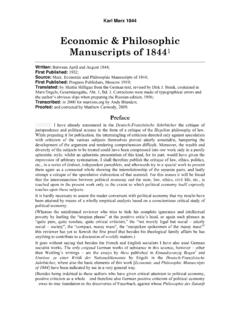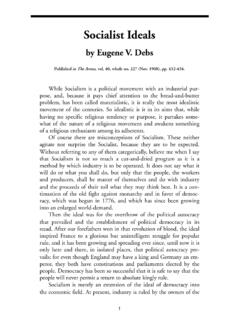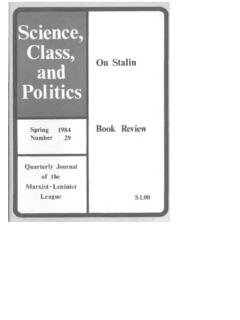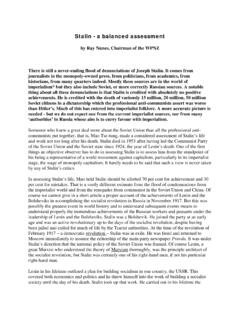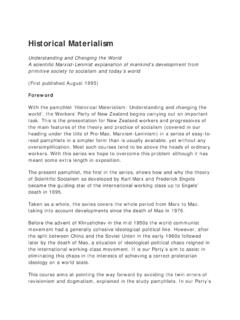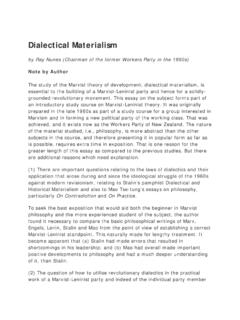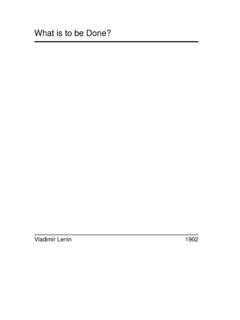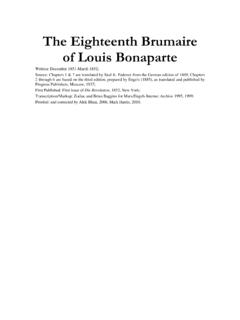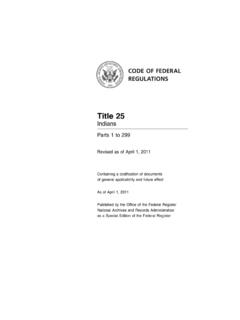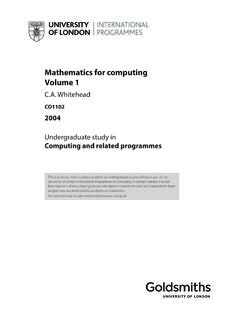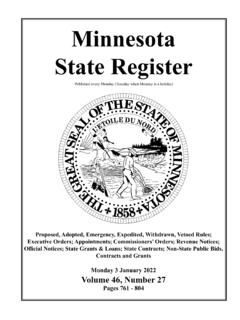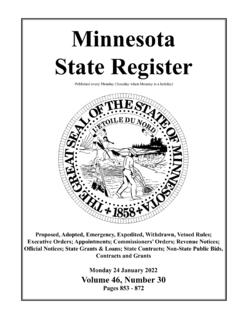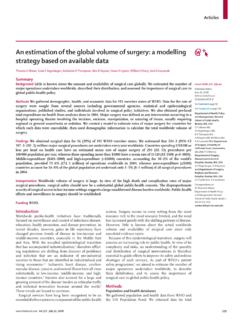Transcription of Capital Volume I - Marxists
1 Capital A Critique of Political Economy Volume I Book One: The Process of Production of Capital First published : in German in 1867, English edition first published in 1887; Source: First English edition of 1887 (4th German edition changes included as indicated) with some modernisation of spelling; Publisher: Progress Publishers, Moscow, USSR; Translated: Samuel Moore and Edward Aveling, edited by Frederick Engels; Transcribed: Zodiac, Hinrich Kuhls, Allan Thurrott, Bill McDorman, Bert Schultz and Martha Gimenez (1995-1996); Proofed: by Andy Blunden and Chris Clayton (2008), Mark Harris (2010), Dave Allinson (2015). Table of ContentsPreface to the First German Edition (Marx, 1867) .. 6 Preface to the French Edition (Marx, 1872) .. 9 Afterword to the Second German Edition (1873).. 10 Afterword to the French Edition (1875).
2 16 Preface to the Third German Edition (1883) .. 17 Preface to the English Edition (Engels, 1886) .. 19 Preface to the Fourth German Edition (Engels, 1890) .. 22 Part 1: Commodities and Money .. 26 Chapter 1: Commodities .. 27 Section 1: The Two Factors of a Commodity: Use-Value and Value (The Substance of Value and the Magnitude of Value) .. 27 Section 2: The Two-fold Character of the Labour Embodied in 30 Section 3: The Form of Value or Exchange-Value .. 33 Section 4: The Fetishism of Commodities and the Secret Thereof .. 47 Chapter 2: Exchange .. 60 Chapter 3: Money, Or the Circulation of Commodities .. 67 Section 1: The Measure of Values .. 67 Section 2: The Medium of Circulation .. 71 Section 3: Money .. 84 Part 2: Transformation of Money into 103 Chapter 4: The General Formula for Capital .. 104 Chapter 5: Contradictions in the General Formula of Capital .
3 111 Chapter 6: The Buying and Selling of Labour-Power .. 119 Part 3: The Production of Absolute Surplus-Value .. 126 Chapter 7: The Labour-Process and the Process of Producing Surplus-Value .. 127 Section 1: The Labour-Process or the Production of Use-Values .. 127 Section 2: The Production of Surplus-Value .. 131 Chapter 8: Constant Capital and Variable Capital .. 142 Chapter 9: The Rate of Surplus-Value .. 150 Section 1: The Degree of Exploitation of Labour-Power .. 150 Section 2: The Representation of the Components of the Value of the Product by Corresponding Proportional Parts of the Product Itself .. 154 Section 3: Senior s Last Hour .. 156 Section 4: Surplus-Produce .. 159 Chapter 10: The Working day .. 162 Section 1: The Limits of the Working day .. 162 Section 2: The Greed for Surplus-Labor, Manufacturer and Boyard.
4 164 Section 3: Branches of English Industry Without Legal Limits to Exploitation .. 168 Section 4: Day and Night Work. The Relay System .. 175 Section 5: The Struggle for a Normal Working Day. Compulsory Laws for the Extension of the Working Day from the Middle of the 14th to the End of the 17th Century .. 178 Section 6: The Struggle for a Normal Working Day. Compulsory Limitation by Law of the Working-Time. English Factory Acts, 1833 .. 184 Section 7: The Struggle for a Normal Working Day. Reaction of the English Factory Acts on Other Countries .. 194 Chapter 11: Rate and Mass of Surplus-Value .. 213 Part 4: Production of Relative Surplus-Value .. 219 Chapter 12: The Concept of Relative Surplus-Value .. 220 Chapter 13: Co-operation .. 227 Chapter 14: Division of Labour and Manufacture .. 237 Section 1: Two-Fold Origin of Manufacture.
5 237 Section 2: The Detail Labourer and his Implements .. 238 Section 3: The Two Fundamental Forms of Manufacture: Heterogeneous Manufacture, Serial Manufacture .. 240 Section 4: Division of Labour in Manufacture, and Division of Labour in Society .. 244 Section 5: The Capitalistic Character of Manufacture .. 248 Chapter 15: Machinery and Modern Industry .. 261 Section 1 : The Development of Machinery .. 261 Section 2: The Value Transferred by Machinery to the Product .. 268 Section 3: The Proximate Effects of Machinery on the Workman .. 271 Section 4: The 284 Section 5: The Strife Between Workman and Machine .. 287 Section 6: The Theory of Compensation as Regards the Workpeople Displaced by Machinery .. 293 Section 7: Repulsion and Attraction of Workpeople by the Factory System. Crises in the Cotton Trade.
6 298 Section 8: Revolution Effected in Manufacture, Handicrafts, and Domestic Industry by Modern Industry .. 304 Section 9: The Factory Acts. Sanitary and Educational Clauses of the same. Their General Extension in England .. 315 Section 10: Modern Industry and Agriculture .. 329 Part 5: Production of Absolute and Relative Surplus-Value .. 358 Chapter 16: Absolute and Relative Surplus-Value .. 359 Chapter 17: Changes of Magnitude in the Price of Labour-Power and in Surplus-Value .. 367 Section 1: Length of the Working day and Intensity of Labour Constant. Productiveness of Labour Variable .. 367 Section 2: Working day Constant. Productiveness of Labour Constant. Intensity of Labour Variable .. 370 Section 3: Productiveness and Intensity of Labour Constant. Length of the Working day Variable .. 370 Section 4: Simultaneous Variations in the Duration, Productiveness, and Intensity of Labour.
7 372 Chapter 18: Various Formula for the rate of Surplus-Value .. 375 Part 6: Wages .. 378 Chapter 19: The Transformation of the Value (and Respective Price) of Labour-Power into Wages .. 379 Chapter 20: Time-Wages .. 384 Chapter 21: Piece Wages .. 390 Chapter 22: National Differences of Wages .. 396 Part 7: The Accumulation of Capital .. 400 Chapter 23: Simple Reproduction .. 401 Chapter 24: Conversion of Surplus-Value into Capital .. 410 Section 1: Capitalist Production on a Progressively Increasing Scale. Transition of the Laws of Property that Characterise Production of Commodities into Laws of Capitalist Appropriation .. 410 Section 2: Erroneous Conception, by Political Economy, of Reproduction on a Progressively Increasing Scale .. 415 Section 3: Separation of Surplus-value into Capital and Revenue.
8 The Abstinence Theory .. 417 Section 4: Circumstances that, Independently of the Proportional Division of Surplus-value into Capital and Revenue, Determine the Amount of Accumulation. Degree of Exploitation of Labour-Power. Productivity of Labour. Growing Difference in Amount Between Capital Employed and Capital Consumed. Magnitude of Capital Advanced .. 421 Section 5: The So-Called Labour Fund .. 426 Chapter 25: The General Law of Capitalist Accumulation .. 434 Section 1: The Increased Demand for labour power that Accompanies Accumulation, the Composition of Capital Remaining the same .. 434 Section 2: Relative Diminution of the Variable Part of Capital Simultaneously with the Progress of Accumulation and of the Concentration that Accompanies it .. 438 Section 3: Progressive Production of a Relative surplus population or Industrial Reserve Army.
9 442 Section 4: Different Forms of the Relative surplus population. The General Law of Capitalistic Accumulation .. 449 Section 5: Illustrations of the General Law of Capitalist Accumulation .. 453 Part 8: Primitive Accumulation .. 506 Chapter 26: The Secret of Primitive Accumulation .. 507 Chapter 27: Expropriation of the Agricultural Population From the Land .. 510 Chapter 28: Bloody Legislation Against the Expropriated, from the End of the 15th Century. Forcing Down of Wages by Acts of Parliament .. 522 Chapter 29: Genesis of the Capitalist Farmer .. 528 Chapter 30: Reaction of the Agricultural Revolution on Industry. Creation of the Home-Market for Industrial Capital .. 530 Chapter 31: The Genesis of the Industrial Capitalist .. 533 Chapter 32: Historical Tendency of Capitalist Accumulation.
10 541 Chapter 33: The Modern Theory of Colonisation1 .. 543 Preface to the First German Edition (Marx, 1867) The work, the first Volume of which I now submit to the public, forms the continuation of my Zur Kritik der Politischen Oekonomie (A Contribution to the Criticism of Political Economy) published in 1859. The long pause between the first part and the continuation is due to an illness of many years duration that again and again interrupted my work. The substance of that earlier work is summarised in the first three chapters of this Volume . This is done not merely for the sake of connexion and completeness. The presentation of the subject matter is improved. As far as circumstances in any way permit, many points only hinted at in the earlier book are here worked out more fully, whilst, conversely, points worked out fully there are only touched upon in this Volume .
